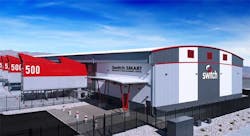Switch Refines MOD Data Center Design for Edge, Smart Cities
Switch believes the building blocks for the digital world will come in different sizes. The company today unveiled new data center designs that package its innovations into a smaller form factor, updating its Modular Optimized Design (MOD) to expand beyond hyperscale facilities.
Switch has been using its factory-built MOD designs to deploy millions of square feet of data center space on massive campuses in Las Vegas, Reno and Grand Rapids, Michigan. The MOD approach uses a template and pre-fabricated components to create a “build once, run anywhere” design integrating Switch’s custom power, cooling and building systems. These projects have all used the MOD 250, a 250-foot wide design optimized for hyperscale environments.
Today Switch introduced the MOD 100, a 100-foot wide data center that can adapt its hyperscale designs to new applications, including edge computing and smart cities as well as localized requirements for enterprise facilities.
The company recently deployed its first MOD 100 unit on its CORE Campus in Las Vegas, completing the project in just six months. The new design reflects Switch’s ambitions to continue to expand into new geographies and provide infrastructure for next-generation technologies.
The updated design from Switch aligns with a major theme here at Data Center Frontier: Data center design will be a differentiator as new capacity is deployed at all points of the network, with pre-fabrication and lean construction techniques playing an important role.
Capabilities for the Edge
“The Switch MOD 100 and MOD 250 are both developed to be the most efficient, resilient and sustainable products delivering 100 percent uptime to meet the demands of Switch’s new and existing customers,” said Missy Young, the Executive Vice President of Corporate Development for Switch. “They are deployable anywhere in the world to provide the highest-rated technology ecosystem possible to support the tremendous growth of the internet of absolutely everything.”
There are several growth areas where the MOD 100 could be deployed. One is edge computing to support bandwidth-intensive consumer applications like video and gaming, where content must move closer to end users to avoid “lag” and poor performance. Switch’s customer list features many marquee names in the content sector, including Marvel, FOX, Lionsgate, DreamWorks, MGM and gaming platform MZ (Machine Zone). The emergence of HD video, virtual reality and e=sports will likely shift data storage closer to user eyeballs over time.
The MOD 100 may also be useful in expanding in international markets with different growth patterns than the hyperscale sector in the U.S. The new form factor allows smaller initial deployments, while allowing for incremental expansion to manage capital and match capacity to demand.
It also may represent a right-sized offering for enterprises that desire single-tenant data centers but don’t want to build or manage the facility. In recent years the focus of the “build to suit” market has shifted to hyperscale projects, but the MOD 100 offers flexibility for a range of requirements.
The exterior of the SUPERNAP data center in Las Vegas, with the exterior cooling units framed by the sky. (Photo: Switch)
An Opportunity in Smart Cities?
Another technology opportunity is smart cities, which is an emerging focus for Switch. This movement seeks to equip cities to to improve their operations and quality of life by leveraging data collected through the Internet of Things. Smart cities can uses sensors and Big Data analytics to manage traffic and parking, track air quality, and even use solar-powered smart trash cans to reduce waste and control pests.
In March, Switch hired Betsy Fretwell as Senior Vice President of Switch SMART, an initiative that will launch later this year and is believed to focus on the government sector and smart cities. Fretwell was previously the city manager for Las Vegas, helping the city develop connected infrastructure for autonomous vehicle testing and shifting the city to 100 percent renewable energy.
In perhaps a hint of things to come, the first Switch MOD 100 in Las Vegas bears signage for “Switch SMART Research & Development Center.” A Switch press release notes that the MOD 100 “can be customized to fit on premise, at the edge or in a dense urban environment on a parcel as small as 400 feet by 400 feet.”
Supply Chain Control as an Accelerator
Switch says that it manufactures 80 percent of the components for its MOD data centers, allowing the company an unusual level of control over its supply chain and delivery timelines. Both the MOD 100 and MOD 250 integrate Switch founder and CEO Rob Roy’s patented data center systems into secure mission-critical facilities offering the highest levels of resiliency and density.
Switch said that the MOD 100 and MOD 250 will support Switch’s proprietary Tier 5 Data Center Standard, which includes resiliency and redundancy seen in other data center ratings systems, but also evaluates additional elements including long-term power system capabilities, the number of available carriers, dual roof, the absence of cooling system lines in or above the data center, physical and network security and 100-percent use of renewable energy.
Here’s a video outlining the features included in the MOD approach.
Focus on Patents and Intellectual Property
As it unveils its new design, Switch says it will be more assertive in defending the intellectual property around its data center designs. In its MOD video, Switch prominently features the patent numbers for its various design features, including its high-density containment system, multi-mode cooling units and power spine design. The company says Roy has received hundreds of patents.
“Rob Roy pioneered massive, modular data centers when he patented his Switch WDMD (Wattage Density Modular Designs) back in 2007,” said Switch Executive Vice President of Policy and Deputy General Counsel Sam Castor. “Today many companies copy these designs in their data centers, and while Switch is flattered, we are also ramping up our IP legal team to address those that are infringing on our patents.”
Patent infringement in data center design has made headlines in recent years through two lawsuits. In 2015, UK engineering firm Bladeroom Group sued Facebook, saying the social networking giant and contractor Emerson Network Power improperly used Bladeroom’s proprietary designs in a data center in Sweden. In 2016, cooling vendor Air Enterprises sued rival Nortek Air Solutions, saying Nortek’s implementation of a cooling system infringed upon its patents for the Kyoto Cooling heat wheel design.
Over the past two years, Switch has been growing in new markets, opening new U.S. data center campuses in Reno, Nevada and Grand Rapids, Michigan, and international campuses in Milan, Italy and Bangkok, Thailand. The company just announced The Keep, a new campus near Atlanta. Upon completion, these projects will bring more than 10 million square feet of data center space online.
Explore the evolving world of edge computing further through Data Center Frontier’s special report series and ongoing coverage.
About the Author



